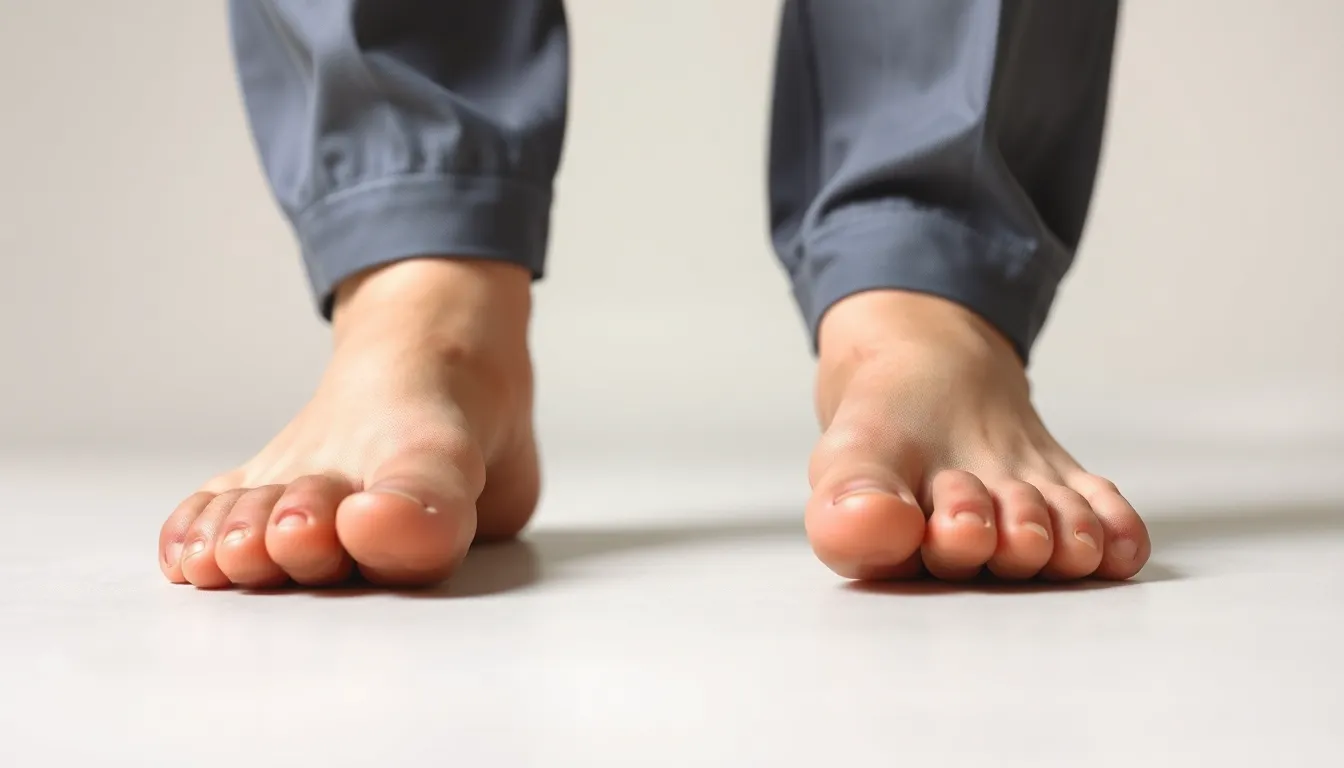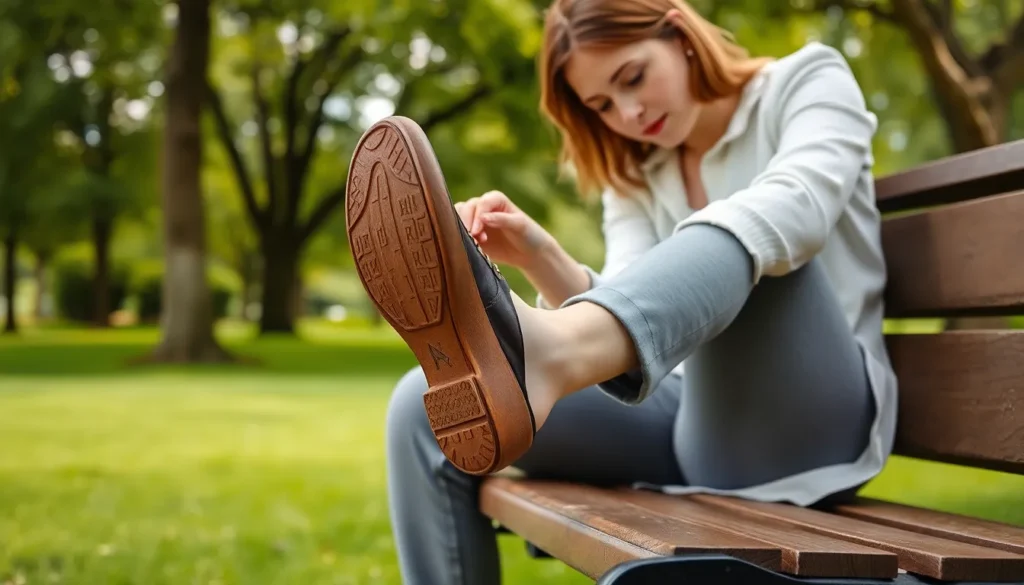Ehlers-Danlos Syndrome (EDS) might sound like a fancy cocktail at a trendy bar, but for those who live with it, it’s no laughing matter—especially when it comes to their feet. Imagine your feet being as flexible as a yoga instructor but not in a good way. EDS can lead to joint hypermobility and skin that feels like it’s auditioning for a role in a superhero movie.
For many, the feet become a battleground of discomfort and frustration. Understanding how EDS affects foot health is crucial for managing symptoms and improving quality of life. So grab your favorite beverage and let’s dive into the world of EDS feet—where flexibility meets foot care, and knowledge is the best remedy for those pesky symptoms.
Table of Contents
ToggleOverview of Ehlers-Danlos Syndrome
Ehlers-Danlos Syndrome (EDS) encompasses a group of connective tissue disorders, each with distinct genetic mutations affecting collagen. Individuals with EDS often experience joint hypermobility, leading to increased flexibility but also frequent joint dislocations. Skin may appear more elastic and fragile than average, making it susceptible to injury and scarring. Symptoms can profoundly affect mobility and overall comfort, particularly in the feet.
Foot-related issues frequently arise in people with EDS, as unstable joints can cause abnormalities in walking and standing. An instability in the foot’s structure often results in pain, excessive wear on joints, and increased risk of injury. Foot deformities such as flat feet, high arches, and bunions can also occur.
Treatment for foot problems associated with EDS may require a multidisciplinary approach. Physical therapy plays a crucial role in strengthening muscles and stabilizing joints. Custom orthotics can provide support and alleviate discomfort, enhancing daily mobility. In some cases, surgeries may be necessary to correct structural deformities or alleviate chronic pain.
Managing symptoms effectively often involves ongoing education and self-advocacy. Understanding the connection between EDS and foot health empowers individuals to make informed decisions about their care. This knowledge aids in recognizing early signs of complications, potentially improving long-term outcomes. Regular consultations with healthcare professionals can help develop personalized strategies to maintain foot health and manage EDS symptoms effectively.
Symptoms of Ehlers-Danlos Syndrome Feet

Ehlers-Danlos Syndrome (EDS) significantly affects foot health. Various symptoms manifest, often leading to complications in daily activities.
Common Foot-Related Issues
Individuals with EDS frequently encounter foot deformities. Flat feet develop due to weak arches, contributing to instability. High arches, another common condition, can lead to discomfort while standing or walking. Bunions form as a result of joint misalignment, causing skin irritation and pain. Ankle instability occurs as a direct consequence of joint hypermobility. Chronic foot problems may arise when these deformities remain unmanaged. Each issue necessitates a tailored approach to treatment that considers the specific mechanics of the feet and the individual’s lifestyle.
Pain and Discomfort
Pain and discomfort often accompany foot-related issues in EDS. Individuals may experience sharp pain or a constant dull ache during prolonged standing or walking. Swelling frequently accompanies these sensations, exacerbating discomfort further. Stiffness usually presents in the morning or after periods of inactivity, impacting mobility. This ongoing discomfort can lead to limited physical activity and decreased quality of life. Temporary relief strategies, such as rest and ice application, may offer support. Consultations with healthcare providers play a crucial role in developing effective pain management plans.
Diagnosis of Ehlers-Danlos Syndrome Feet
Diagnosing Ehlers-Danlos Syndrome (EDS) requires a thorough approach. Comprehensive assessment includes both physical examination and genetic testing.
Physical Examination
Healthcare providers conduct a detailed physical examination to identify characteristic signs of EDS. They evaluate joint hypermobility, which often indicates the condition’s presence. Observations may include skin elasticity and any associated foot deformities. Additionally, assessing an individual’s medical history provides context for potential symptoms. Identifying common foot issues like flat feet or bunions further supports the diagnosis. Each finding contributes to a clearer picture of how EDS affects foot health.
Genetic Testing
Genetic testing plays a crucial role in confirming EDS diagnosis. Testing identifies mutations in collagen-producing genes that cause the disorder. Healthcare professionals usually recommend this testing when clinical symptoms suggest EDS. Results from these tests provide definitive evidence of the syndrome. Understanding specific genetic mutations helps tailor treatment plans. It also aids in identifying family members who may be affected. These insights ensure ongoing monitoring and management of foot-related complications.
Treatment Options for Ehlers-Danlos Syndrome Feet
Individuals with Ehlers-Danlos Syndrome (EDS) face unique challenges that require tailored treatment options for foot health. A multidisciplinary approach often provides the most effective management.
Physical Therapy
Physical therapy plays a crucial role in managing EDS-related foot issues. Therapists develop customized exercise plans that strengthen muscles around unstable joints. Strengthened muscles provide better support, helping to stabilize feet and ankles. Stretching exercises increase flexibility while aiming to reduce pain. Graduated exercise regimens can progressively improve mobility, enhancing overall physical function. Walking techniques may also be addressed to minimize joint stress. Regular sessions with a licensed physical therapist promote long-term improvements in foot health, ultimately enhancing the quality of life.
Orthotics and Footwear
Custom orthotics serve as essential tools for individuals with EDS. These specially designed shoe inserts correct alignment and provide additional cushioning where it’s needed. Proper footwear choices reduce strain on joints and enhance stability, reducing the risk of injury. Supportive shoes with arch support help manage common foot deformities like flat feet and high arches. Individuals should consider shoes with a wide toe box to accommodate deformities without causing additional discomfort. Ongoing assessments by podiatrists can ensure that orthotic solutions remain effective as foot conditions change.
Living with Ehlers-Danlos Syndrome Feet
Individuals with Ehlers-Danlos Syndrome (EDS) frequently encounter challenges related to foot health. Foot deformities, such as flat feet and bunions, often develop due to joint instability and weak arches. These conditions lead to chronic pain and can hinder mobility.
Managing discomfort requires effective strategies. Resting the feet and applying ice can alleviate temporary pain, while therapeutic exercises enhance stability. Moreover, seeking advice from healthcare providers remains essential for developing personalized pain management plans.
Custom orthotics play a vital role in treatment. These specialized insoles correct alignment and support arches, reducing strain during daily activities. Additionally, proper footwear contributes significantly to foot health. Shoes that provide arch support and feature a wide toe box accommodate deformities, enhancing comfort.
Physical therapy stands out as an important component of care. Therapy not only strengthens muscles around unstable joints but also improves overall mobility. Regular assessments by podiatrists ensure that orthotic solutions adapt to changing foot conditions over time.
Ongoing education empowers individuals to advocate for their health. Knowledge about EDS and its impact on foot mechanics leads to informed decisions regarding care. Collaboration with healthcare providers fosters a multidisciplinary approach, incorporating various treatment modalities tailored to each person’s unique needs.
Frequent follow-ups contribute to long-term success in managing foot health. Consistent communication with specialists allows adjustments in treatment as conditions evolve. A proactive attitude toward foot care can enhance quality of life for those living with EDS.
Ehlers-Danlos Syndrome significantly impacts foot health and overall quality of life. Individuals with EDS face unique challenges due to joint instability and painful foot deformities. Understanding these challenges is crucial for effective management.
Tailored treatment plans that include physical therapy, custom orthotics, and appropriate footwear can alleviate discomfort and improve mobility. Regular consultations with healthcare providers ensure that strategies evolve with changing conditions.
By prioritizing foot health and advocating for personalized care, individuals with EDS can enhance their daily lives and maintain greater independence.

